
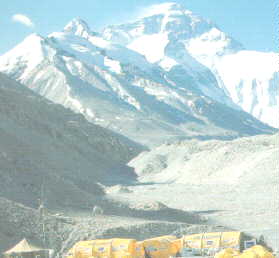
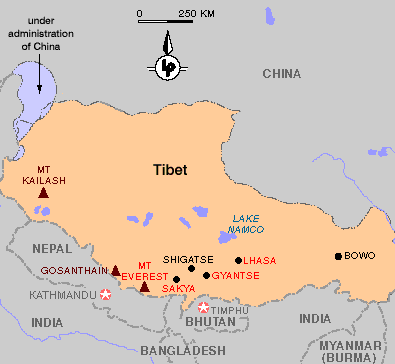
Tibet has often been called the "Roof of the World." The plateau is probably the largest and highest area ever to exist
in Earth history, with an average elevation exceeding 5000 m (16,400').
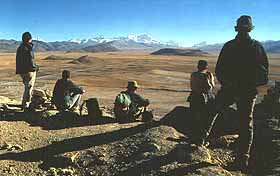
From Tingri (4,390 meters) its possible to see four of the highest peaks in the world, including Mt. Everest.
The Tibetan Plateau covers an area about half that of the lower 48 United States and is bounded by the deserts of the Tarim
and Qaidam Basins to the north and the Himalayan, Karakoram, and Pamir mountain chains to its south and west. Its eastern
margin is more diffuse and consists of a series of alternating deep forested valleys and high mountain ranges that run approximately
north-south, bounded by the lowlands of the Sichuan Basin of China.
Tibet has remained a very difficult place to visit and is more fantastic than imagined. It is a land of immense contrasts:
snowy peaks and sandy deserts, barren plateaus and forested mountains, empty expanses and crowded cities, and a deeply religious
people ruled by an avowedly atheistic government.
LHASA
Lhasa, capital of the Tibet Autonomous Region, covers an area of 544 square kilometers and is "The Land of Gods" in Tibetan,
sits on the north bank of River Lhasa, a tributary of the Yarlung Tsangbo River, at an altitude of 3,700 meters. It has a
history of over 13 centuries. With more than 3,000 hours of sunshine annually, Lhasa is famed as " the City of Sunshine".
It is the capital of Tibet Autonomous Region and the center of Tibet's political, economic, cultural and religious activities.
There are many historic sites and famous relics in the city proper and its suburbs, among which the Potala Palace, Jokhang
Temple, Drepung Monastery, Sera Monastery and Gandan Monastery are world famous.
Before the mid-seventh century when Lhasa, later a central town of Tibetan region, was yet to come into being, the area
called Wotang was a marshy land of wildness, frequented by antelopes. On one bright summer day, Songtsan Gampo, leader of
the Tubo tribe that had risen to power in the Yarlung River Valley, was struck by the perilous position of an area flanked
by two steep mountains, while bathing in the Lhasa River, and decided that this was to be the home of his kingdom. This ambitious
Tibetan king moved the center of his rule to Wotang and ordered the construction of his residence on the hilltop of Potala.
In 641 A.D., Songtsan Gampo who by this time had conquered the whole Tibetan region wedded Princess Wencheng of the Imperial
Tang Court. When the princess arrived, she became convinced that Lake Wotang was a devil's heart to be overpowered by the
construction of a grand temple after filling up the lake with earth. The princess further suggested that the earth be carried
by white goats. This imposing grand temple became a symbol of the kingdom. The temple, later known as Jokhang, was initially
named Lhasa, "the Sacred Land" in Tibetan. Over the centuries, Lhasa became a political and religious center of Tibet. Administrative
orders were issued from the myriad of imposing palaces; the great temples and monasteries were home to omnipotent liturgical
establishment and witnessed the rise of many religious leaders and endless religious ceremonies. The faithful composed the
population of the town and Lhasa became a true "Mecca" of Tibet.
Potala Palace, symbol of Lhasa, is on the top of the Potala Hill. The palace, 117 meters tall and 40 meters wide, has towering
buildings with golden roofs and a group of huge castle palaces, which is divided into white and red palaces for the color
of their walls. The white palace used to be a place where the living Buddha, Dalai, Tibetıs religious leader, handled government
affairs and lived. The red palace is further divided into the Hall of the Buddha, Scripture Hall and Memorial Hall, each with
a dozen or scores of rooms. The Hall of the Buddha houses gold-traced portraits of Sakyamuni and deceased Dalai Lamas. The
Scripture Hall keeps in it a large number of early copies of Buddhist sutras; and the Memorial Hall contains stupas of the
13 late Dalai Lamas.
Potala Palace is also a world of murals, which are painted in hundreds of halls and corridors. It is a huge treasure house
for Tibetan history, religion, culture and arts.
Norbu Lingka Park, or "Treasured Garden", is located in the west of Lhasa. With a layout similar to imperial gardens in
the Chinese interior, the park was a summer resort for Dalai Lamas. In the garden, colorful, exotic flowers are shaded by
towering rare trees, and golden buildings and the lake add radiance and beauty to each other.
Tsetang (Zetang), the birthplace of earliest Tibetans, sits on the south bank in the middle section of the Yarlung Tsangbo
River with a moderate climate at an altitude of 3,600 meters. The nearby Yarlung River scenic area is a national scenic park
with Samye Monastery, Yumbu Lhakang Palace, burial site for Tsampos and Traduk Monastery spotting the region.
ANCIENT MEGALITHIC RUINS
There are dozens of sites spread over 400, 000 square kilometers, documenting the existence of the legendary Zhang zhung
kingdom.
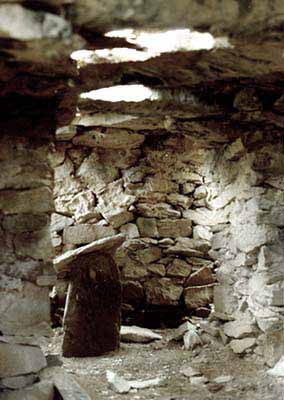
Celestial Observatory - Black Rock
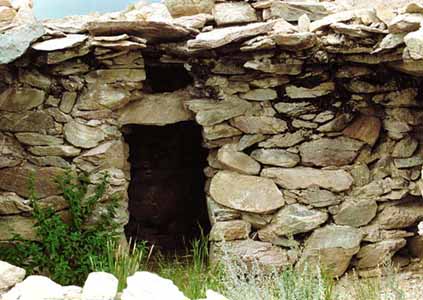
Also at Black Rock are the remains of what appear to be chortens (mchod rten), and tenkhar (rten mkhar), shrines used in
the worship of environment-based deities.

Remnants of Stone Ring Ceremonies
ART
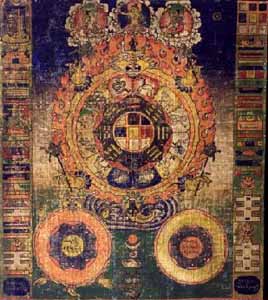
Tibetan art can be grouped into three parts:
Flat - Paintings which include 'Thangka', Fresco, Wooden Tablet and Sand Painting
Solid - 3-dimension - objects which include Bronze, Clay Sculpture, Clay Modeling, Wooden Carving, Stone Carving, Ritual
Objects, Butter Sculpture, Mask and Cazha, and
Costumes - The thangkas are painted or embroidered images rendered on cloth, silk or paper which is mounted on a cloth
backing and may be rolled up like a scroll when not hung.
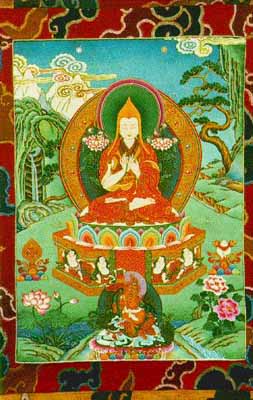
A thangka composed of strung pearls is kept in Dradrug Monastery in Shannan. Thangka is a special art of Tibet. The material
used for thangka is linen cloth or coarse woolen fabric or silk or paper. The cloth needs to be prepared first and then the
artist works out the sketches of the portraits with charcoal sticks. The drawing usually begins at the center. Colouring comes
last. The pigments used come from non-transparent minerals and plants such as malachite and cinnabar. They are mixed with
animal glue and ox bile to make the lustre stay.
There are many schools of painting which may be classified as the Eastern Tibetan, the Middle Tibetan, the Western Tibetan.
The Eastern Tibetan was the oldest and heavily influenced by those of the Han nationality. This style is individualistic and
probably too free for the taste of Buddhists. The Western school began after the Indian master Atisa came to Tibet in the
11th century (Song Dynasty). Atisa brought Nepalese painters to work according to the rigid rules. The Middle Tibetan School
is an integration of the above two.
Tibetan fresco painting is an important part of Tibetan art. The painting of Buddha image must follow the rigid principles
and the proportion diagrams set out in the `Pratibimbalaksana-sutra' (`The Textbook on Measurements for Image-Making') and
the `Pratibimbamana-laksana (`Measurements for Painting') in the Silpakarmasthana-vidya. The finished product is well-proportioned,
stately and serene-looking deity.
The pigments used are similar to the one used for thangka painting. Frescoes cover wider range of subjects than thangkas
do. They include the images of Buddha in his many manifestations, portraits of saints, great masters, founders of various
Buddhist sects and the stories of their lives, wars, scenes of manual labour, construction of monastories and everyday life
of the people. They are especially effective in creating a mystic atmosphere in the monasteries which will lead the viewers
to believe that `this is where the Buddha resides'.
Wooden Tablet Painting represents yet another branch of Tibetan art. Its subjects and pictorial composition are similar
to those of thangka and the difference is that the pictures are drawn on wooden tablets of various shapes. Some of them have
handles attached to them for holding and hanging.
The materials for Sand Painting are coloured sand and minerals. They are filled inside a cone with a tiny hole at the tip.
Many disperses though the hole will form a single line in the picture. The subject is usually `mandala'.
As Buddhism believes in the worship of idols (as against a teaching of Buddha), the production of the images of Buddhas
and other deities must follow the strict rules prescribed in the cannon for their faces, gestures, the ornaments they wear
and the objects they hold. The Tibetan artists absorbed the influences of the art of Han, Nepalese and Indian sculpture and
developed a style and craft of their own which was distinctively Tibetan. The shaping of a bronze is a complicated process.
It is so difficult and time-consuming that sometimes many artists spent all their lives making them but did not live to see
them completed.
There are numerous Clay sculptures preserved to the present day. Most of them are sculptures of Buddhas, saints and great
figures. Some of them are with treasures preserved inside.
Clay modeling of miniature Buddhist image, called `phyag-tsha' or `tsha-tsha' in Tibetan, represents a form of artistic
expression in Tibetan Buddhism. As the modelings are not difficult to make and the material is easily obtainable, such objects
of art are turned out in large quantities by Tibetan. They can be found almost everywhere.
These beautiful engravings lavishly decorate the columns, beams, door, windows and cross-beam supports in Tibetan monasteries
and temples. Shrines, platforms seating deities, altars, stupas and some ritual objects are often adorned with wood carving
or stone carving.
Most Butter Sculptures produced in Lhasa and elsewhere are made for the Lamp Festival on the fifteenth day of the first
month of the Tibetan year. The butter is first mixed with ice water, then mineral dyes mixed in. Working on a wooden support,
a world of flowers and grass and towers and buildings, populated with men and animals and deities, is then created.
Masks depict the range of beings from deities to men and animals, qiangmu religious dances and folk tales. Those depicting
humans are carved to display a certain characteristic such as honesty, harshness, greed or humor. Animals depicted are mainly
deer, yaks, sheep and birds.
"Cazha" is an ancient traditional form of sculpture creating mainly the statues of Buddhas and Bodhisattvas. Engraved on
the back of the wall are scriptures of prayers for good luck and prosperity. The wall is an object of various size, the wall,
therefore, is called "Thousand-Buddha wall".
RELIGION
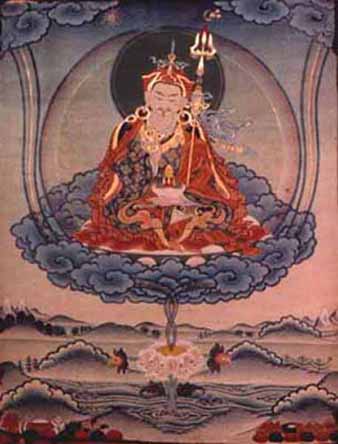
The Tibetan Buddhism is Great Vehicle (Mahayana) Buddhism. There are two parts of it: the Exoteric and the Esoteric Buddhisms.
The Tibetan Exoteric Buddhism is based on Madhyamika (dBu-ma, `middle way') of Nagarjuna. The Tibetan Esoteric Buddhism, which
is different from all other Esoteric Buddhisms, makes the Tibetan Buddhism unique. The Tibetan Buddhism requests the study
of the Exoteric Buddhism as the foundation and puts the Tibetan Esoteric Buddhism as the most advanced form of Buddhism. We
assume that our visitors have a basic knowledge of the Exoteric Buddhism.
The doctrine of the Tibetan Esoteric (i.e. Tantric) Buddhism is based on `Mahavairocana-sutra', and `Kalacakraindriya-sutra'.
Its theory may be summarized as follows: "taking the six elements as essence", "five Buddhas and five wisdoms", "taking the
four mandalas as appearance", "taking the three secrets as means", "cause, base, final means" and "anger and fear".
"Taking the six elements as essence" is the Esoteric interpretation of the origin of the cosmos. According to the Esoteric
Buddhism, the six elements, the earth, water, fire, wind, air and ether ( consciousness), make up the dhamakaya (cosmic body)
of the Mahavairocana. They provide the nature of all creation and are at once the source and the foundation of the existence
of all phenomena. As they are possessed by all beings in the universe, they exist in the mind of the laity. This is the something
Buddha shares with the layman. However, according to the Esoteric Buddhism, the laity are incapable of recognizing the nature
of cosmic beings, "unless they are aided by the supreme benevolent power of the Tathagata", which means the practice of "the
three secrets" is necessity if one wishes to purify one's mind and recognize the nature of all cosmic beings.
The three secrets are: body secret, speech secret and mind secret. The follower must conform his body, speech and mind
to those of the Buddha. "Taking the three secrets as means" refers to a form of meditation during which the meditator, with
specified gestures and in specified sitting posture, recites the true teaching of the Satyadevata or yidam (the most honoured
of all Buddhas) while concentrating on evoking the deity's image before his inward eye. For the follower, it is not enough
to do no evil, for he must impress the image of Satyadevata deeply in his mind. It is not enough to not use any coarse and
foul language, for he must recite the deity's true teaching: it is not enough to entertain no wicked ideas, for he must never
forget the vows and wishes of the Satyadevata. By doing so, he will eventually be "purified", achieve "the perfect body of
the Buddha", and "reach the Buddhahood in the present body".
"The four mandalas" refers to the different types of mandala. The mandala in Sanskrit (Tibetan: dkyil-vkhor) means "rostrum"
or "rostrum ground". In ancient India, the mandala was a round or square mud platform at a meditation site erected to ward
off "demons" during meditation sessions of the Esoteric Buddhists. When a king ascended to the throne, or when a monk was
ordained, the ceremony would take place on a mandala. To these ceremonies, all the deities representing the past, present
and the future from all the cosmic compass points (east, west, south, north, northeast, northwest, southeast and southwest
from high above and down below) would be invited as witnesses to these occasions, and on the platform their images would be
drawn. Later on, different types of mandala were developed, of which the following four are the most common:
1. The Great Mandala, at which the presence of the deities from their respective areas are drawn in green, yellow, red,
white and black to represent "the earth, water, fire, wind and air".
2. The Samadhi mandala, at which the presence of the deities is shown not by the drawings of their images, but by those
of the pearls, swords or wheels they carry so that the mediators may associates these objects with the images of the deities
and practise visionary meditation.
3. The Dhama Mandala, at which the deities are not represented by the drawings of their images, or those of the objects
they carry, for it is believed that the sight of the initial syllables in Sanskrit of their titles will invoke their images
in meditators.
4. The Karma Mandala, where carved, sculptured or cast figures of the deities are set up to impress the meditators with
the vivid, life-like sight of these deities.
The mandala is the manifestation of the Mahavairocana and the occasion on which he spreads his teachings to earthy beings
so that the worshippers of mandalas, with the aid of the Tathagata, will be able to "dispel the clouds of troubles and spiritual
obstacles". As the spiritual communication with deities can be done only by means of the four mandalas and by reciting their
true teachings, the practice is described as "taking the four mandalas as appearance".
"Five Buddhas and five wisdoms" is one of the major doctrines of the Tibetan Esoteric Buddhism. According to the doctrine,
one will not "reach Buddhahood in the present body" just by reciting the true teachings and practising the mandala. He needs
the five wisdoms of the Five Dhyani-Buddhas (Vairocana, Aksobhya, Ratnasambhava, Amitabha and Amoghavajra), namely the wisdom
of the universal law, the wisdom of the mirror, the wisdom of equality, the wisdom of distinction and discernment, and the
wisdom of accomplishing works. When a person has acquired the five wisdoms, he will be able to achieve Buddhahood without
abstaining from meat,wine or sex. However, these wisdoms cannot be obtained unless they are passed on by the guru himself.
The concept represented by "the five wisdoms" is a spiritual requirement, essential to anyone seeking Buddhahood. It is a
concept which promised mystical transforming power.
The "cause, base and final means" is the condensed version of the three lines in the Mahavairocana-sutra:
The mind of bodhi is the cause.
The great compassion is the base.
The upaya (path,method) is the final means.
The first line means that followers of the Esoteric doctrine must first achieve the mind of bodhi. such mind will grow
like a seed and eventually lead one to Buddhahood. Without this mind, no one can hope to be accepted by the Buddha, and therefore
is not qualified for the practice of the Esoteric doctrine. The second line means that the follower must also be a person
of great compassion. This compassion will enable him to liberate all beings by encouraging them to practise virtuous deeds
in much the same way as root and trunk of a tree give the tree its leaves, blossoms and fruits; hence the term "the base".
The third line means the path the follower takes and the flexibility he is given. "The final means" may be interpreted
as "thoroughness" and "the end", representing the objective, while "upaya" can be taken to mean "flexibility" and "ingenuity"
in pursuing the final means. In other words, the follower in his pursuit of Buddhahood, may, when condition warrants it, be
excused from the observance of some rules of Buddhist discipline. For example, Buddhism forbids sex, but followers of the
Esoteric Buddhism may have female companions for meditation.
The practice of having female companions for meditation is called " the union of voidness and happiness" or the union of
the two polarities (yab-yum). This practice, based on the theory of the Mahavairocana-sutra and the Vajrasekhara-sutra, is
a distinctive feature of the Esoteric Buddhism. Sex is strictly forbidden by the Exoteric Buddhism, but it is part of meditation
practice in the Esoteric Buddhism.
As Vajrasekhara-sutra says, "How pure is man's mind! It's only natural that lust should change him. Keeping away from lust
will restore purity in him, and keeping away from lust means conquering it with another form of lust." Sex is thus shrouded
in mysticism and given the role of "conquering lust". It becomes a mean by which the follower of the Esoteric Buddhism can
achieve self-purification of his nature.
According to the Esoteric Buddhism, "the attraction of lust will draw one into the realm of the wisdom of the Buddha",
that is, by means of carnal love the bodhisattva leads one to liberation. This accounts for the fact that the Esoteric Buddhism
treats women as offerings. What "The Collected Works of Buddhism Literature" terms as "love for offerings": refers to the
love for women. This theme is repeated in the Mahavairocana-sutra, which says,"Satisfy the desire for sex so that all beings
will be happy."
According to the Esoteric Buddhism, Mahavairocana lives in Heaven like an earthy being- accompanied by the Marici (Queen
of Heaven) and surrounded by female attendants. As a result, the rajas (devas and vajras), instructed by Mahavairocana to
subdue demons, are in their "wrathful forms" accompanied by devis, their female counterparts.
The Esoteric Buddhism preaches the idea of "taking upaya (compassion) as father and prajra (wisdom) as mother" and takes
the union of rajas and devis in each other's embrace as the symbol of "the union of compassion and wisdom". To a follower
of the Esoteric Buddhism, his spiritual teacher is his father, and the teacher's female companion his mother (dakini), and
the great union of happiness of man and woman is the path which will lead to the "acquisition of supernatural powers (siddhi)".
This explains why yab-yum is also called "the path of women".
The yab-yum, together with its practice that the teaching of the disciple by his teacher is done only privately, has produced
a symbolic and arcane language used during meditation. For example, the phallus is called "vajra", the vulva becomes "the
lotus flower" (padma), and copulation is described as "entering into the realm of samaya". Yab-yum and the concept of great
happiness originated in Saktism (Shaktism). According to this sect, all cosmic beings were created by the sexuality of goddesses.
Copulation, therefore, was regarded as a form of worship of the goddesses and an expression of reverence for them. These notions
were borrowed by the Esoteric Buddhism and, combined with Buddhism doctrines, produced the theory of "the union of voidness
and happiness".
In addition to Queen of Heaven and the devis, among the deities revered by the Esoteric Buddhists are, the Rdo-rje gro-lod
(the Wrathful Guardian Deity) and the Bhairava Vajra (the fearful Guardian Deity), who are the two deities representing the
doctrine of "wrath" and "fear". Rdo-rje and Bhairava Vajra are names for all wrathful and fearful-looking vajras. According
to tradition, the Buddha may appear in two forms: sometimes in his real form of Kindness and at other times in his wrathful
manifestation.
The Mahabhairava Vajra, the principal deity of the Dge-lugs-pa Sect (gelug-pa, new yellow hat), for example, is the wrathful
manifestation of Amitayus. The Mahabhairava Vajra, whose duty is to subdue flaming demons, has six faces, six arms, six feet
and three eyes. He holds in his hands various kinds of sceptres.
He rides a green water-buffalo, wears a helmet studded with human skulls, and has a tiger's skin for a kilt. With flames
emitting from his body, he looks extremely wrathful and fear-striking. This fearful look is intended to demonstrate to all
beings that to themselves from avidya (ignorance) they must break down all spiritual barriers with the power of wisdom, and
overwhelm demons with all the power they possess.
In Buddhist terms, all spiritual and material obstacles to Buddhahood are demons which must be tamed, resisted or brought
under control with one's innate strength.
Li Jicheng, assistant researcher of World Religions of the China Academy of Social Sciences.
CALENDARS
In the 7th century, Princess Wen-Cheng brought Tang's calendar to Tibet, later Princess Jin-Cheng did the same thing. Apparently,
they did not bring with them the theoretical Astronomy which the calendars were based on. Those Tibetan students who were
sent to Tang to study Arithmetics did not learn the computations to make calendars. After the down fall of the Tibetan Dynasty,
Tibet became chaotic, and the transmissions of the Han calendars stopped, Tibetan were left without a scientific calendar
until 11th century.
Around 9th century, Islam extended to India, many Indian Buddhists escaped to Tibet with `aru-yoga' of the Esoteric (Tantric)
Buddhism. Its part of `Kala (time) Wheel' was a part of the Indian Astronomy, and not up to the early Tang's achievement.
Tibetan fused the Indian Astronomy, the Tibetan creativities and the Han calendars (rgya-rtsis) to form their own calendars,
later they adopted more from the Han calendars to form the present Tibetan calendars.
The main purposes of the Tibetan calendars were (1) providing a working seasonal schedule for farmers, shepherds, etc.
(2) dating the enlightening date of Buddha, for Buddha propheted that Buddhism would exist for 5,000 years (different schools
might have different figures). If we knew the precise date of the enlightening of Buddha, then the end of the world of Buddhism
would be open to us. The important clue was that there was a complete moon eclipse on the enlightening day of Buddha. (3)
computing the moon and sun eclipses. The complete moon eclipse on the date of the enlightening of Buddha indicated the importance
of moon or sun eclipses which should increase one's intelligence 1 million times. Therefore, it was important to predict the
timing of them for a believer to meditate or study.
MEDICINE
In the 8th century, the Han medicine (`Complete Treatise on Medicine') was transmitted to Tibet by the two Tang Princesses
Wen-Cheng and Jin-Cheng. Doctors from Tang, India and Nepal were invited to Tibet. A Tang doctor, Tashi-Donsongonwa (his Han
name was lost), was invited twice to Tibet, and became famous. The Tibetan saint of medicine, Yutok Yonten Kongpo was among
his pupils. The Tibetan saint traveled to Tang, Nepal, India, wrote the important `Four Part Medical Classic' which was considered
to be the canon to this date. Note that this canon had been continuously edited, modified in the last thousand years, some
later Buddhism influences were obvious.
During the revival of the Buddhism in Tibet, many Indian monks were fond of medicine, and transmitted Indian medicine to
Tibet. The three vital activities, `lon', `qibo' and `paigen', were formulated under the influences of the Indians and the
Hans.
Due to the process of cutting bodies in the `skyburials', the Tibetan Anatomy was excellent. Tibetan had a vivid picture
of human body. The Tibetan doctors observed the development of fetuses, and divided the period of pregrancy into `fish period',
`turtle period', `pig period'. This was a discovery in embryology.
Similar to the Han tradition, a series of `Materia Medica' (`ben cao' in Han) were compiled.
Both Tibetan and Han doctors regard illnesses as having been caused by imbalances in the biological rhythm of the human
organism, i.e. in the Tibetan medicine, it means the imbalances of the three `vital activities', seven `components, and three
`excreta'. They may be summarized as `cold' and `hot' diseases.
The main methods employed in the Tibetan medicine are: observing, inquiring, and pulse-taking. Note that they are identical
with the Han medicine in principle. The most important ones are urine-observing and pulse-taking.
The healing arts are: food, living habit, medicine, and outside therapeutics.
MARRIAGE
In Tibet, the marriages are of three types:
(1) monogamy - 90% of all marriages
(2) `one husband multi-wives'
(3) `one wife multi-husbands'. The prevailing
marriages are monogamy with `multi-wives' and `multi-husbands' permissible.
Most families are patriarchal. The men usually make the important decisions, buying and selling, paying tributes to the
deities, horse racing, hunting etc. The women are the mainstay of family life. They are busy from morning till night, milking
cows, making tea, roasting and grinding barley, making butter and curd, making clothes and looking after children. The ten
years or older kids shepherd, gather yak-dung (as fuel for cooking and heating), fetch water.
FOOD
Due to the high altitude of Tibet, the water boils at 90 degree Celsius, and cooking with water is impossible. The diet
and foods are peculiar in Tibet. The Tibetan diet consists mostly of meat, milks and other high-protein foods. The main staple
is `tsamba'. Tea is a necessary. Travelers usually bring dried meat, tsamba, and tea for foods.
CLOTHING
The Tibetan robes, which serve as blankets at night, are very long and are worn down to the knees with the extra length
tucked and held up by a waistband or belt. The robe produces two large pockets, one in front and another at the back, for
people to carry things, including baby. When it is hot in the daytime, Tibetans will undress the right arms to disperse heat.
If it is even hotter, then one may undress both arms and tie the sleeves around the waist.

TIBETAN STONE DISCS
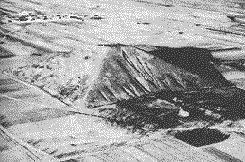
TIBETAN PYRAMIDS
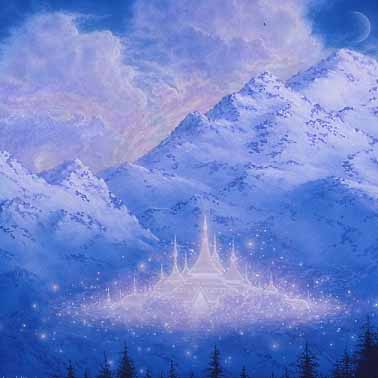
MYTHICAL SHAMBALA

